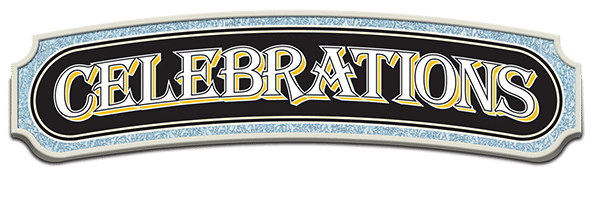8 Unusual Uses of Color at Walt Disney World

1. Pink Sidewalks for Parading
As you walk down Main Street, U.S.A., World Showcase in Epcot, or throughout Disney’s Hollywood Studios, you may notice that the sidewalks are tinted pink. Why? Well, the pink hue of the sidewalks actually makes the surrounding landscaping appear brighter. How? Red and green are complementary colors, meaning they are opposite each other on the color wheel. Complementary colors provide the strongest contrasts to one another, and when placed alongside each other can make both appear brighter. The pinkish hue of the sidewalks contrasts nicely with the green grass and shrubbery, making both appear just a little bit brighter. The surrounding foliage would be somewhat more drab if the sidewalks were a standard gray.
2. Colors of Nature
Speaking of foliage, Guests often take the surrounding flowers and plants for granted, but they too play an integral part in establishing the mood of your surroundings. Note the contrast between the sculpted trees in Tomorrowland, which lend an air of geometric precision to the world of the future, with the natural appearance of the plantings in Adventureland and Frontierland that help to reinforce the untamed nature of these exotic lands. But just as important is the use of color. Adventureland is overflowing with lush greens that evoke the deepest and darkest jungles of Africa and South America, while over at Liberty Square and the American Adventure, you’ll note that the plantings are comprised of red, white, and blue flowers.
3. A Landscape of Color
At the Land Pavilion, the surrounding landscape is planted in distinctive rows to represent the lushness of the natural environment, with the trees at the top sporting white blooms to evoke the clouds in the sky.
4. Magical Colors for a Magical Hat
Sometimes the effort to provide a unique colorscape results in new innovations, such as the paint treatment that was used to allow Mickey’s Sorcerer Hat (the former icon of Disney’s Hollywood Studios) to shimmer in a myriad of brilliant colors as you walked around it, an effect accomplished by using a specially formulated paint called chameleon paint.
5. All Grays Are Not the Same…
Cinderella Castle looks to have a simple two-color scheme during the day, but in reality seven different shades of gray are used at different elevations to enhance the grandeur of this magnificent structure.
6. …And Neither Are All Whites
At the American Adventure, you’ll note that the trim appears to be a uniform white, but such is not the case. Several different shades of white were carefully selected based on a variety of criteria. The first was the environment; the Florida sun can be quite strong and can greatly influence the perception of colors, including white. Another is the fact that the same shade of white can appear in different hues when placed next to different colors. On the American Adventure building, the white used in the trim on the building facade is a warm white so that it blends well with the color of the bricks. If you could compare them side by side, you would see that the white used in the trim on the roof is much cooler (bluer). That’s necessary due to the dark blue tiles of the roof. If the same white were used in both places, it would look very different and would create a startling contrast.
7. Go Away!
On the other end of the spectrum, the Imagineers also developed a color dubbed “Go Away Green.” This shade of gray green is rather nondescript, and that is precisely the point: it is used on fences, garbage cans, construction walls, and any other areas that are not meant to be a part of the action. The eye tends to gloss right over this color, and that is exactly what the Imagineers intended!
8. Jeweled Mosaics
But back to Cinderella Castle and its walk-through breezeway. What could have been a simple walkway from Main Street to Fantasyland is transformed into a magical journey via five immense mosaic murals depicting Cinderella’s story. Five-hundred different colors can be found within the mosaics, which boast more than one million pieces of glass, in addition to accents of silver and 14-carat gold. A very special use of color can be found in the fourth mural, in which the prince slips the wayward glass slipper onto Cinderella’s foot. Her step-sisters stand by in bitter, wide-eyed amazement: Anastasia’s face has a reddish hue, symbolizing her anger at what has transpired, while Drizella’s face is green, signifying envy.

